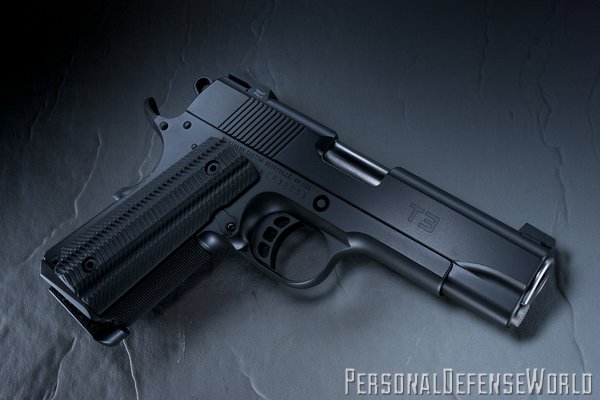In 2008 and again in 2009, I had the chance to shoot two variations of the Nighthawk Custom T3, the company’s “Ultimate Concealed Carry Pistol.” What makes it ultimate — even for lovers of the 1911—is that it’s a cross between the subcompact, Officer’s-size 1911 and the mid-size, Commander-type 1911. All steel with G10 grips, the first Nighthawk T3 I shot was black all over (including the aluminum trigger), except for the barrel and bushing. The Nighthawk T3 I was able to shoot in 2009 was made from stainless steel. I found that these pint-sized, Browning-design guns felt distinctly different from the conventionally framed 1911, though there was only a 0.12-inch difference in width. I had to acclimate myself to the Nighthawk T3s, and that doesn’t normally happen when I handle Government- and Commander-sized guns.
The T3 is popular, and it’s chiefly due to the still-growing concealed carry market. But Nighthawk Custom didn’t rest on its laurels. Part of making a gun fit the user’s hand is the length and circumference of the weapon’s gripping portion. So Nighthawk Custom thinned the original T3 design.
Covert 1911?
Advertisement — Continue Reading Below
The idea of a more concealment-friendly 1911-type pistol is hardly new. In the years following World War II, the military tried to identify a service sidearm that was more user-friendly than the Government Model 1911. The design was old, and many pistols were fitted so loosely that they’d run with boulders and logs caught inside, so Government 1911s were seen as inaccurate—tightening them up made them unreliable in battlefield conditions. Rumor had it that the 1911 was incapable of clustering hits on a washtub at 15 feet and that the .45 ACP cartridge was so powerful that, while it could knock down an attacker from a graze across a fingernail, it could knock down the shooter as well with its recoil. No one could be taught to shoot it.
Forget that pistols of the Government pattern routinely won matches at the national level. And disregard that many people—from law enforcement officers to soldiers—routinely carried such guns into battle in the nastiest conditions on Earth. Never mind that Colonel Rex Applegate and his kind would bring people up to speed on his close-range combat shooting in one hour with the old warhorse pistol. Not to mention that the 1911 was the signature weapon of the Modern Technique of the Pistol as documented by Colonel Jeff Cooper.
In time, the Government Model 1911’s barrel and slide were shortened and its frame was made of aluminum, resulting in the Commander. Colt followed this in the 1970s by making this model with a steel frame and calling it the “Combat Commander,” one of the most balanced 1911-format pistols in history. The Commander’s slide and barrel are a little shorter and therefore a little lighter, creating a noticeable difference between its recoil stroke and the Government Model 1911’s.
Advertisement — Continue Reading Below
Nighthawk Custom’s contribution was to take that smallest of reliable 1911 formats, the Commander, and marry it to the shorter, Officer’s-size frame. You lose a cartridge in total capacity, taking us back to the original 1911’s seven-round magazine, but gain in concealment due to the length of the pistol’s butt, the hardest part to conceal. In the T3 Thin, Nighthawk Custom has trimmed the frame’s gripping surface and improved the T3’s ergonomics for a better feel. What’s not to like?
Gun Details
Using appropriately shortened hexhead screws, thin G10 scales are affixed to the sides of the T3 Thin’s frame. As to the frame, I didn’t have a standard-width 1911 nearby to take measurements, but in a tactile sense, the T3 Thin feels thinner. The frontstrap and mainspring housing are thinned, making the grip frame shorter from front to back. And Alien-pattern VZ Grips are installed, which VZ describes as having “just the right amount of bite.” That’s a good way of putting it.
Advertisement — Continue Reading Below
My test pistol, chambered in .45 ACP and sporting a steel frame (though aluminum is available upon request, as is a model chambered for the 9mm), arrived in a Nighthawk Custom range bag with a key ring and bushing wrench, all of which bore the company’s logo. A pair of seven-round magazines (a stainless Nighthawk Custom magazine and a blue ACT-MAG), a test target and an instruction manual also came with the gun. It should be noted that I didn’t need the bushing wrench to turn the barrel bushing.
The T3 Thin’s magazine well is a blessing. The cavernous mouth helps with quickly feeding an empty pistol, and the added length, which is slight enough to not compromise concealment, helps stabilize the pistol in hand. Open at the front, the cut in the frame allows you to latch onto the floorplate of any magazine that won’t drop free.
Previous T3 pistols of my acquaintance had trigger pulls weighing less than 4 pounds. Per my Timney trigger pull gauge, the T3 Thin consistently broke at 4.5 pounds of pressure to drop the hammer. This is a street-weight trigger with a sharp and positive reset and almost no amount of take-up.
My test pistol had fine checkering on the frontstrap and mainspring housing. The base of the grip safety has three depressions, and the safety is firm, with a solid click when positioning it on and off. The National Match barrel, marked “NHC 45ACP NM,” and the bushing are stainless steel. The muzzle is cut flush to the barrel bushing and is nicely crowned. The slide stop stud is cut flush with the right side of the frame. To facilitate disassembling the pistol, the transverse hole is countersunk.
Advertisement — Continue Reading Below
The entire gun is nicely rounded with no sharp edges, just the way a concealed-carry gun should be. The sights are optimum for range and defense, though the new T3 Thin differs from a number of current offerings in that it doesn’t have a fiber-optic front sight. Note that fiber-optic tubes are great in strong overhead light, but most shootings occur in conditions with compromised or adverse lighting. This makes the T3 Thin’s Heinie night sights a better choice, especially for a service or carry pistol. For holsters, Nighthawk is well known for producing customized, contour-fit leather rigs that should work perfectly with the T3 Thin and allow you to carry it all day comfortably.
Range Time
Shooting the T3 Thin revealed no surprises. I found that, as the conventionally sized pistol (regardless of make or model) is reduced in length, it feels rounder in the hand. There is no greater circumference to the gripping part of the handgun, but it seems that way due to the reduced height and the minimal grip of the small finger. The T3 Thin felt absolutely like a full-sized Government Model 1911. The reduction in its frontstrap and mainspring housing, along with the thin stocks, makes this gun feel proportionally correct in the hand.
Advertisement — Continue Reading Below
I tried three loads in the T3 Thin. The Black Hills 230-grain JHP, a standard-pressure load, is a preferred utility round and serves well for just about any .45-caliber gun. This ammunition is as accurate as it needs to be while easily feeding into the gun and possessing .45 ACP power. I also used the ASYM 230-grain Practical Match FMJ. Throttled to “make major” in 5-inch guns, it’s appropriately fast in a Commander-class barrel while being accurate and feeding reliably. Finally, I fired the load some 1911s love to hate: the 185-grain semiwadcutter FMJ “softball.” This cartridge was originally loaded to allow the use of the .45 in centerfire matches, rather than adapting the .38 Special wadcutter to feed in autopistols. The 185-grain SWC is not particularly powerful, and its short overall length can make it a bit sketchy in cycling with some 1911s.
The gun ran through 300 rounds of .45 ACP loads of various pedigrees. The top accuracy was seen from the lightest load, the Federal Premium SWC FMJ. Remarkably, the T3 Thin took to this load and fired it without a stoppage.
The ASYM load took second place in terms of the best five-shot group; the T3 consumed that load like it was candy. The Black Hills ammunition was fast-stepping and still quite accurate from the little 1911. I decided to forgo my usual handling test and fired upon 2-inch Shoot-N-C bullseye targets at a distance of 7 yards away. I had to slow down a little bit to ensure hits, but the short, clean, firm trigger made it easy to keep every round on those small targets.
Advertisement — Continue Reading Below
Final Notes
Is seven rounds enough when it comes to capacity? Well, it is a .45, but that’s hardly the point. My mistake is often being magazine-poor. For you, the solution is to select the magazine you and your gun both like and then stock up on them. The T3 concept is easily the best form of the 1911-class pistol for concealed carry. The execution of the concept in this, the third of Nighthawk Custom’s T3 series I’ve used, is simply superb. I was not disappointed at all.
While it’s become somewhat chic to criticize the combination of 1911 pistol and .45 ACP cartridge for self-defense, the people I know who have made this selection seem to be quite confident in their choices. If this style of gun and cartridge are your preference, too, try the T3 Thin from Nighthawk Custom. You will not be disappointed. For more information, visit nighthawkcustom.com or call 877-268-4867.
Advertisement — Continue Reading Below
























